For more pictures see facebook
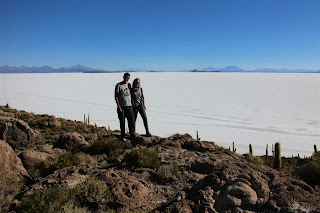 One of the most spectacular things to do in South America is to visit Salar de Uyuni, the largest salt flat in the world. Uyani is 11 hrs by bus from La Paz along a very bumpy unpaved road. The only buses which go are night buses, but with chairs that recline to 160 degrees, food and a movie, I didn´t think we had anything to worry about. Thank god we didn´t know we were going to be travelling on the equivalent of a dirt road for 11 hours or the dread would have been worse than the actual journey. We left La Paz at 9pm and arrived in Uyuni at 7am the next morning. Despite having little sleep we were ok spirits and had the chance to explore the town before heading off on our three day tour of the salt flats the next day.
One of the most spectacular things to do in South America is to visit Salar de Uyuni, the largest salt flat in the world. Uyani is 11 hrs by bus from La Paz along a very bumpy unpaved road. The only buses which go are night buses, but with chairs that recline to 160 degrees, food and a movie, I didn´t think we had anything to worry about. Thank god we didn´t know we were going to be travelling on the equivalent of a dirt road for 11 hours or the dread would have been worse than the actual journey. We left La Paz at 9pm and arrived in Uyuni at 7am the next morning. Despite having little sleep we were ok spirits and had the chance to explore the town before heading off on our three day tour of the salt flats the next day.
Uyuni is a sleepy little town in the middle of nowhere, where they survive almost entirely on tourism. It was founded in the late 1800s as a trading town and still has the railway linking Bolivia to both Chile and Argentina. We arrived into town on Thursday, which was market day, but despite the many stalls the place was still pretty dead and we were happy to leave the following day on the 3 day tour of the Salar.
The first stop on the tour is immediately outside town at train cemetery. The train cemetery is really a dumping ground for old trains from the late 1800s early 1900s, where they slowly rust and collapse. It is a really interesting place and has become an unintentional tourist destination on the way to the Salar. There is talk of painting the trains and making them a little safer, as people clamber over, in and around them and I´m sure there must have been a few accidents.
However, in true Bolivian style, everything thing is done at your own risk and while accidents do happen, for the most part its safe and it´s great to just be able to enjoy the trains as they are in all their dilapidated beauty.
Once out on the Salar, the landscape takes on an unworldly dimension. As the sea retreated and evaporated, large coral like islands were left behind surrounded on all sides by miles and miles of salt. The salt forms into large hexagon shapes which stretch out into the horizon. The glare from the suns rays bouncing off the salt creates a mirror effect, where the reflection of the mountains can been seen in what looks like water surrounding them.
Not far into the Salar we visited the village of Colchani. Here most of the buildings are made of salt blocks cut from the Salar and the main livelihood is collecting salt, processing it and selling it. All of the work is done by hand. Many of the villagers cycle out onto the Salar and shovel the top layer of salt into piles to dry. It is then taken to a drying house where it is further dried, ground down and bagged.
Its a lot of work for very little return but machinery is expensive and labour isn´t so without investment things will continue to be done the traditional way.
 Further out onto the Salar we visited the island of Incahuasi which was covered in giant Cacti some over 1000 years old. The island is the top of an old volcano which was submerged when the plates began to move and pushing up the land and cutting off the sea, creating the salt lakes and now the salar.
Further out onto the Salar we visited the island of Incahuasi which was covered in giant Cacti some over 1000 years old. The island is the top of an old volcano which was submerged when the plates began to move and pushing up the land and cutting off the sea, creating the salt lakes and now the salar.
The whiteness of the surrounding salt distorts perspective and allows you to create some really unique pictures. Our driver, well versed in this, took along a T-Rex toy and some other props for us to mess about with. That night we slept in a salt hostel on the far side of the Salar. The walls, bed, chairs, table and even the floor was made out of salt.
 The next morning we set out across a completely different, seemingly barren landscape to the flamingo lagoons. along the way we stropped to look at the Quinoa fields which exist between 2000 and 3000 meters above sea level. It is amazing that such a high protein food can grow in fields where the clay looks completely dried out and depleted of any nutrients. Bolivian export of quinoa has exploded in recent years and because most locals cannot afford to buy pesticides, they have accidental stumbled upon the ´cash cow´ that is organic food. The price of quinoa has tripled since 2006 and the demand from North America and Europe for organic, protein rich quinoa and other organic agricultural produce has increased the need for Bolivia to regain its access to the sea. Bolivia has been land locked since it lost the War of the Pacific with Chile in 1879 and Chile claimed the far west of the region blocking it off from the sea. They are currently taking the matter to the International Courts in the hope of preventing a war which Bolivia would have no hope of winning.
The next morning we set out across a completely different, seemingly barren landscape to the flamingo lagoons. along the way we stropped to look at the Quinoa fields which exist between 2000 and 3000 meters above sea level. It is amazing that such a high protein food can grow in fields where the clay looks completely dried out and depleted of any nutrients. Bolivian export of quinoa has exploded in recent years and because most locals cannot afford to buy pesticides, they have accidental stumbled upon the ´cash cow´ that is organic food. The price of quinoa has tripled since 2006 and the demand from North America and Europe for organic, protein rich quinoa and other organic agricultural produce has increased the need for Bolivia to regain its access to the sea. Bolivia has been land locked since it lost the War of the Pacific with Chile in 1879 and Chile claimed the far west of the region blocking it off from the sea. They are currently taking the matter to the International Courts in the hope of preventing a war which Bolivia would have no hope of winning.
Just in time for lunch we reached the first of the Andean lagoons, Laguna Hedionda, where brightly coloured flamingos feed on the pink algae which lives in the shallow water. The flamingos were amazing. They seemed completely oblivious to the tourists snapping pictures of them and would happily stand a meter away eating, perhaps knowing the tourists wouldn’t venture into the muddy water.
We passed numerous lagoons before passing in the Eduardo Avaroa Andean Fauna National Reserve and the highest desert in the world. The whole area is highly volcanic with smoking volcanoes, geyser parks and hot pools. The highest park of the park was over 4,960 meters above sea level, not far off the Everest base camp which sits at 5,364 metres above sea level.
On the second night we stayed at a hostel right beside some hot pools. After dinner we all grabbed some beers and headed to the pools for some star gazing. The next morning, a few of us decided to get up in time for sun rise. At such high altitudes the morning are particularly cold (-15 degrees) so there was nothing for it but to jump back into the hot pools again. Our towel which got a little wet was left on a rock by the waters edge and subsequently froze solid.
After breakfast we visited the last of the lagoons, Lagona Verde before dropping off some of our group at the Chilean border. The border exists in the middle of nowhere and there is nothing for miles except a lowly shack which passes as the Bolivian Emigration office and a small trench which marks the border.
We spent most of the 3rd day diving back to Uyuni, stopping only for lunch and a quick opportunity to climb some rocks in Valley of the Rocks. The impressive rock formations have been made from the water washing away at the null rocks for thousands of years. Once back in Uyuni we had time for a quick bite to eat before jumping on the next night bus to Tupiza and our next adventure!
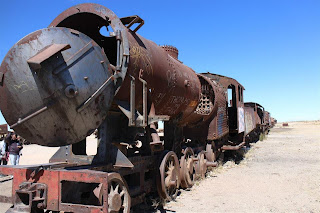
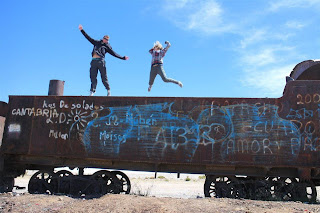




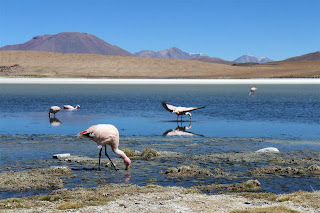
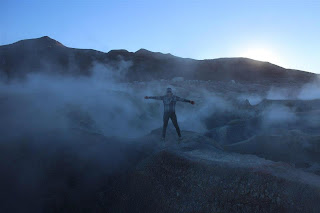



What’s up, of course this article is truly fastidious
and I have learned lot of things from it regarding blogging.
thanks.